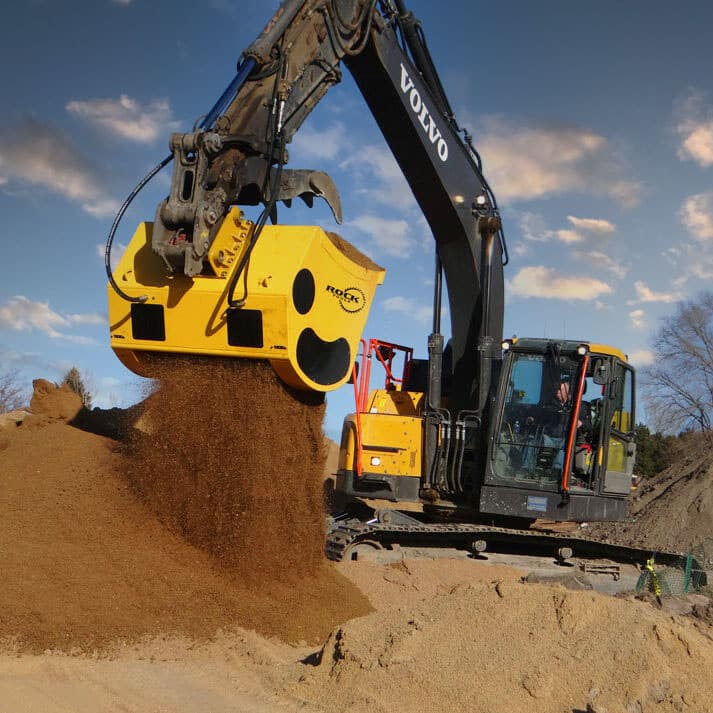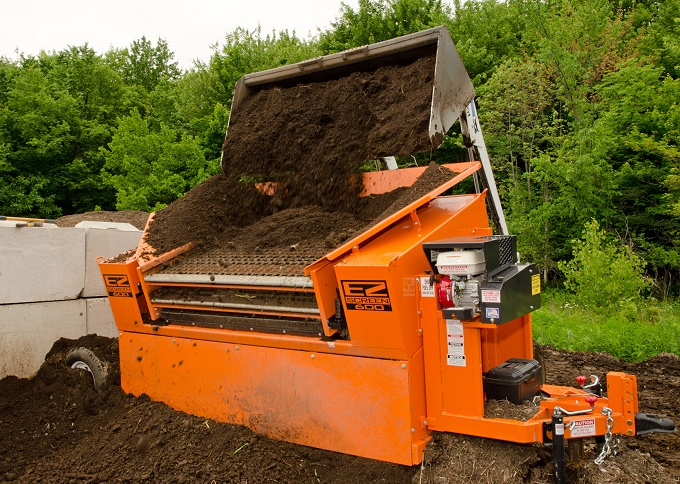Change Your Testing Procedures with a State-of-the-Art Dirt Screen for Sale
Change Your Testing Procedures with a State-of-the-Art Dirt Screen for Sale
Blog Article
Enhance Material Recovery With State-Of-The-Art Dirt Screens for Recycling Facilities
In today's world, where ecological sustainability is a pushing worry, reusing centers play a pivotal function in minimizing waste and saving sources. Optimizing material healing can be an intricate procedure, frequently impeded by the presence of dust and particles in the reusing stream. This is where advanced dirt screens enter play, supplying an encouraging service to boost material recuperation rates. By successfully separating undesirable impurities, these sophisticated displays hold the potential to reinvent reusing facilities' procedures. How specifically do dirt displays improve product healing? What are the key features that make them cutting edge? And just how can reusing centers implement them effectively? In this conversation, we will check out the solutions to these inquiries and dig into real-life case studies that highlight the effective integration of dust displays in recycling centers. Prepare to find the transformative power of state-of-the-art dirt displays and their effect on boosting product healing.
The Importance of Dirt Screens in Recycling Facilities
Dirt displays play a critical duty in reusing centers by effectively separating dirt and other pollutants from recyclable materials. These screens, also referred to as trommel screens, are created to successfully remove unwanted particles and ensure that functional and just clean products are refined even more.
The main function of dirt screens is to divide bigger items of dust, rocks, and various other non-recyclable products from the stream of products. By doing so, they prevent these pollutants from going into the reusing process and possibly destructive equipment or compromising the high quality of the end product.
Additionally, dirt screens aid to improve the total effectiveness of reusing operations. By getting rid of dust and other contaminants early at the same time, the screens decrease the quantity of manual work needed to arrange and clean the materials in the future. This not just saves time however also boosts and reduces costs productivity.
In addition, using dirt displays contributes to ecological sustainability. By making sure that just tidy and unpolluted products are refined, recycling centers can generate higher-quality recycled items. This, subsequently, motivates the usage of recycled products in various industries, reducing the need for virgin sources and lessening the ecological impact of source extraction and manufacturing processes.
Exactly How Dust Screens Improve Product Recuperation
Using dirt screens in reusing centers dramatically boosts the procedure of product recovery. These screens play an important function in dividing dust, debris, and various other undesirable materials from the recyclable stream, resulting in enhanced performance and higher high quality outcome.
One of the major methods in which dirt screens boost product recovery is by eliminating impurities that can prevent the recycling procedure. Dust, rocks, and various other non-recyclable items can trigger damage to equipment, lower the performance of subsequent sorting processes, and infect the final recycled materials. By successfully screening out these pollutants, dirt screens assist guarantee that the recyclable products stay pure and of high top quality.
Additionally, dirt displays make it possible for reusing centers to recoup a better quantity of useful products. By eliminating dirt and particles, the displays permit a more exact sorting procedure, boosting the recuperation rate of recyclable materials. This means that better sources can be redeemed and reused, minimizing the need for virgin materials and lessening the ecological impact related to their removal and production.
In enhancement to enhancing product healing, dirt screens also add to the total efficiency of reusing facilities. By protecting against tools damage and reducing downtime caused by blockages and clogs, these displays assist keep a continuous and smooth recycling procedure. This enhanced efficiency equates right into price savings and enables higher throughput, inevitably enhancing the success and sustainability of reusing operations.
Trick Functions of State-of-the-Art Dust Screens
To additionally enhance the efficiency and effectiveness of product recovery in reusing facilities, cutting edge dust displays are outfitted with crucial attributes that maximize the splitting up procedure and ensure the finest quality result (dirt screen more for sale). These features include sophisticated testing modern technology, adjustable setups, and robust construction
One key attribute of modern dirt displays is their sophisticated testing innovation. These displays are made with precision-engineered mesh or perforated plates that efficiently separate dirt and particles from the recyclable materials. The size and spacing of the openings in the screens can be tailored to suit different kinds of products, allowing for efficient separation and maximum healing rates.
Another vital feature of these dirt displays is their personalized settings. Reusing facilities can adjust the speed, angle, and amplitude of the screens to enhance the splitting up process. This adaptability enables operators to tweak the screens according to the specific demands of the materials being refined, causing enhanced accuracy and higher healing prices.
In addition, advanced dust displays are developed with robust building and construction to endure the extreme problems of recycling centers. They are made from durable products such as stainless steel or high-strength alloys, ensuring longevity and marginal downtime as a result of maintenance or fixings. Additionally, these screens are designed with very easy accessibility for cleaning and upkeep, facilitating reliable procedures and lowering downtime.
Actions to Executing Dust Screens in Recycling Facilities
What are the essential actions for integrating dirt screens into reusing facilities? Applying dust screens in recycling centers includes an organized strategy to ensure reliable setup and procedure. The adhering to are the essential steps to successfully include dust displays:
Evaluation: Conduct a detailed evaluation of the facility's needs and demands to identify the ideal dirt screen requirements. Think about aspects such as product type, quantity, and preferred splitting up efficiency.

Installment: Prepare the facility for the setup of the dirt screens. Comply with producer guidelines and ensure correct placement and integration with the reusing process.
Evaluating and Calibration: Once the dirt screens are mounted, conduct thorough testing to make sure appropriate functioning. dirt Get More Information screen for sale. Calibrate the system to attain preferred splitting up performance and minimize material loss
Training and Upkeep: Train personnel on operating and preserving the dirt screen system. Develop a regular upkeep schedule, consisting of cleaning and examination, to make sure optimum efficiency and durability.

Study: Successful Material Recovery With Dirt Screens
Integrating dirt displays right into reusing centers has shown to be a successful approach for achieving reliable product healing, as demonstrated by numerous case research studies. These study highlight the favorable effect of dust displays on the general recycling procedure.
One notable study originates from a reusing center in a significant city. By applying dust displays, the facility had the ability to significantly decrease the amount of contamination in their recyclable products. This brought about enhanced arranging precision and raised recovery prices for useful materials such as paper, steel, and plastic. The introduction of dust displays also aided to tear and reduce the wear on arranging devices, decreasing upkeep costs and downtime.
One more situation research showcases a country recycling center that dealt with too much dust and particles in their inbound waste stream. By setting up dust displays, the facility had the ability to remove a huge portion of the unwanted materials, causing cleaner recyclables and improved efficiency in the sorting procedure. This resulted in higher material recuperation prices and minimized waste sent out to the garbage dump.
These study demonstrate that including dust screens into recycling centers can have a substantial positive effect on material recuperation. By properly getting rid of dust, debris, and various other pollutants, recycling facilities can improve their total recycling prices, minimize landfill waste, and maximize the worth of retrieved materials.
Verdict
To conclude, making use of cutting edge dirt displays in reusing centers is crucial for boosting product recovery. These displays efficiently eliminate dirt and particles, permitting the reliable splitting up and healing of important materials. By executing dirt screens, reusing facilities can considerably boost their reusing procedures and contribute to a much more sustainable future.
One of the major methods in which dirt screens enhance product recovery is by eliminating impurities that can hinder the recycling procedure. By successfully evaluating out these contaminants, dust screens aid Full Article ensure that the recyclable materials continue to be pure and of high top quality.
Moreover, dirt displays allow reusing facilities to recuperate a better amount of important materials.In enhancement to enhancing material healing, dust displays additionally add to the general effectiveness of reusing facilities.In final thought, the use of advanced dirt displays in reusing facilities is critical for enhancing material recuperation.
Report this page